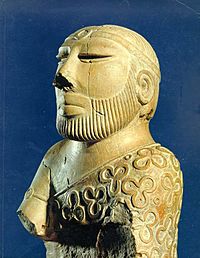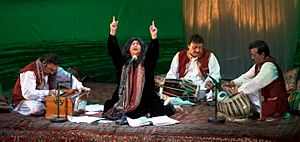Sindhi people facts for kids
| Total population | |
|---|---|
| c. 32 million | |
| Regions with significant populations | |
| 29,500,000 | |
| 2,772,264 | |
| 341,000 | |
| 30,500 | |
| 30,000 | |
| 11,500 | |
| 10,000 | |
| 9,801 | |
| 8,800 | |
| 7,500 | |
| 700 | |
| Languages | |
| Sindhi | |
| Religion | |
| Predominantly Islam Minority Hinduism and Sikhism |
|
The Sindhi people (Sindhi: سنڌي, सिन्धी) are a group of people who speak the Sindhi language. They originally come from the Sindh province in Pakistan. They are part of the larger Indo-Aryan family.
After India was divided in 1947, many Sindhi Hindus and Sikhs moved to the new country of India. They also moved to other parts of the world. Today, you can find Sindhi people in both India and Pakistan. Most Sindhis in India are Hindu, while most Sindhis in Pakistan are Muslim.
Sindhi Muslim culture is deeply shaped by Sufism. Sufism is a mystical branch of Islam. Famous Sindhi cultural figures include Shah Abdul Latif Bhitai and Lal Shahbaz Qalandar.
Contents
History of the Sindhi People
Ancient Times in Sindh
The Indus Valley Civilisation was a very old culture. It existed in the region where Sindhis live today. This civilisation ended around 1700 BC. We don't know exactly why it ended. It might have been due to an earthquake or a natural event. This event could have dried up the Ghaggar River.
Later, the Indo-Aryans arrived. They are thought to have started the Vedic civilisation. This happened around 1500 BC. This early civilisation helped shape many cultures in South Asia.
Sindh Through the Ages
For many centuries, parts of Sindh were ruled by different empires. These included the Persians, Greeks, and Kushans. This happened between 500 BC and 500 AD. Alexander the Great also marched through Sindh. He traveled down the Indus River after conquering the Persian Empire.
Sindh was one of the first areas to be conquered by Arabs. This happened around 720 AD. This brought the influence of Islam to the region. Before this, Sindh was mostly Hindu and Buddhist. After 632 AD, Sindh became part of the Islamic empires. These included the Abbasid and Umayyid empires. Later, local dynasties like the Habbari and Soomra ruled Sindh.
Sindhi Identity and Beliefs

The region of Sindh is named after the Indus River. The people living there are called Sindhi. The words "Hindi" and "Hindu" also come from "Sindh." This is because ancient Persians pronounced "s" as "h." So, they called the people "Hindhu" and the region "Hindh." This name was later used for a large part of northern India.
The Ror dynasty ruled Sindh from 450 BC to 489 AD. The two most important Sindhi tribes are the Soomro and the Samma. The Soomro ruled Sindh from 970 to 1351 AD. The Samma ruled from 1351 to 1521 AD. These tribes are from the same family line. Other Sindhi groups include the Bhuttos and Lohanas. In Sindh, people often feel connected by their shared Sindhi background. This is more important than their specific tribe.
Sindhi Muslims
Sindh's location made it important for trade. This also meant it was often conquered by foreign empires. In 712 AD, Sindh became part of the Islamic Empire. It was known as the "Arabian gateway" to India. It was also called Bab-ul-Islam, meaning "the gate of Islam."
Most Sindhi Muslims follow the Sunni branch of Islam. A smaller number are Shia Muslims. Sufism has greatly influenced Sindhi Muslims. You can see this in the many Sufi shrines across Sindh. These shrines are places where Sufi saints are honored.
-
Inside the beautiful Shah Jahan Mosque, Thatta, built during the Mughal Empire.
Sindhi Hindus
Before Islam arrived, Hinduism was the main religion in Sindh. In 1998, about 8% of Sindh's population was Hindu. Most Sindhi Hindus live in cities like Karachi and Hyderabad. Hyderabad is a major center for Sindhi Hindus in Pakistan.
Before Pakistan became independent in 1947, about 25% of Sindh's population was Hindu. Many Hindus moved to India when Pakistan was created. This was part of the Partition of India. The cities and towns of Sindh had many Hindu residents. For example, in 1941, Hindus made up 64% of the city population.
Sindhi People Around the World
Many Sindhi people have moved to other countries. This movement, called the Sindhi diaspora, started before the 19th century. Sindhis have settled in places like Europe, the United States, and Canada. There are also large Sindhi communities in Middle Eastern countries. These include the United Arab Emirates and Saudi Arabia.
Sindhi Culture and Traditions
Sindhi Names and Family Names
Muslim Sindhis often have traditional Muslim first names. These names sometimes have local variations. Sindhi families also have names based on their jobs or where their ancestors came from.
Sindhi Hindus often have family names that end with '-ani'. This ending comes from a Sanskrit word meaning "descended from." The first part of the family name usually comes from an ancestor's name or a place. In northern Sindh, family names ending in 'ja' (meaning 'of') are also common. For example, a person's family name might be their village name followed by 'ja'.
Images for kids
-
Zulfiqar Ali Bhutto, who was the ninth prime minister of Pakistan.
-
Fahad Mustafa, a Sindhi actor in Lollywood.
-
Abida Parveen, a well-known Sufi musician.
See also
 In Spanish: Pueblo sindi para niños
In Spanish: Pueblo sindi para niños














